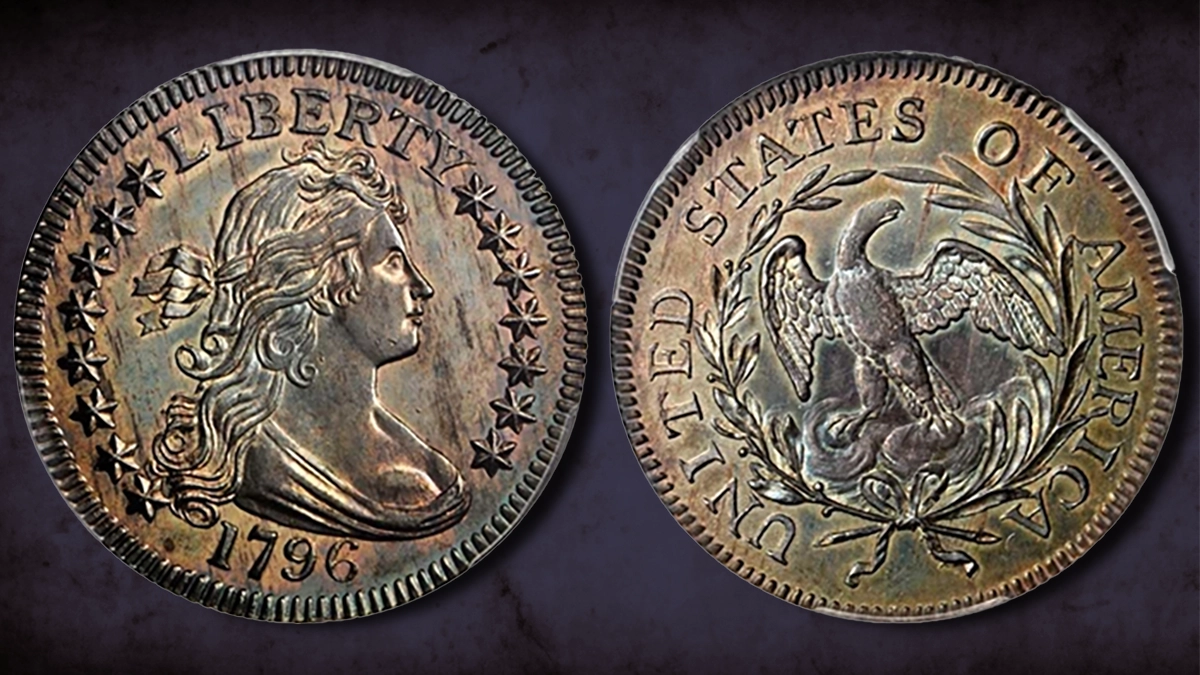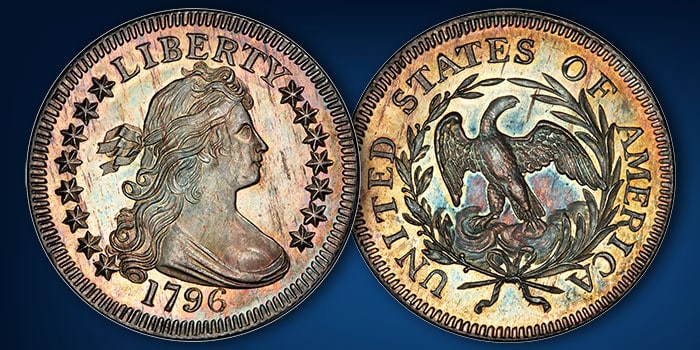The Most Famous Dime
Those growing up in the 1990s likely remember the cartoon Duck Tales and Scrooge McDuck and his “lucky dime.” In the cartoon and the old comic books, Scrooge’s lucky dime represented the first dime he ever earned. This was a totem for the millionaire mallard as it represented the drive and ambition that made him a successful businessman. On the other hand, the coin was a distillation of Scrooge’s all-consuming obsession with wealth, a personality flaw that effects all “scrooges,” unfortunately.

The character Scrooge McDuck and his lucky dime actually predates the show by decades, first appearing in a 1947 comic book story by Carl Banks titled “Christmas on Bear Mountain.” Banks based the character on Charles Dickens’ Ebenezer Scrooge from his timeless classic A Christmas Carol, but over time, the character developed a softer edge.
As to what date and type of dime it was, artists and storytellers over the years have been vague and inconsistent. The coin has been depicted as a dime dated 1899, has featured the Mercury Dime motif of 1916-1945, and in perhaps the most fleshed out of Scrooge origin stories is identified as an 1875 Seated Liberty Dime. A worn 1875, in the condition depicted in Don Rosa’s The Life and Times of Scrooge McDuck, first published in 1992, would today cost you about $40.
A far more famous dime is the 1916-D Mercury Dime, a low mintage silver coin that was scarce even in its own time. Today, even a completely worn example will set you back a cool thousand dollars, but we recommend that you buy only examples that have been certified as authentic.
Much rarer by orders of magnitude is the 1894-S Barber Dime. This is a branch mint Proof coin of which only two dozen were made. A few of the coins were supposedly given to the daughter of the mint superintendent, who is said to have spent one on ice cream. This story doesn’t make much sense to us, but two examples did surface in California in the 1950s
Today, only nine examples are known and examples routinely sell for more than $1 million at auction.
The Most Famous Twenty-Cent Piece

You’d be forgiven for being unfamiliar with the Twenty-Cent Piece. Given the ubiquity of the quarter, one might think, “why bother” with creating a coin that is worth five cents less? Its creation in 1875 was largely due to appease Western silver miners who wanted a coin that could be used more easily to count bullion by weight, and to eliminate the issue of short-changing with Spanish-American coins in the West where decimal coinage conversion was sometimes difficult.
Apparently, Americans felt the same way about the “double dime” upon its release, as the denomination was only officially struck from 1875 to 1878 before its abolition. A key problem was that the coin was too similar in size and design to the Liberty Seated Quarter, leading to confusion and public rejection. The twenty-cent piece had a plain edge, unlike the quarter’s reeded edge, but this wasn’t enough to prevent confusion.

The 1876-CC Twenty-Cent Piece struck at the Carson City Mint is indeed the key rarity. Its scarcity stems directly from the Act of May 2, 1878, which called for the immediate suspension of the production of the denomination. This legislative act led to the melting of millions of coins across all years and mints. The surviving 1876-CC coins, of which only a handful are known, are so rare because almost the entire mintage was melted at the Carson City Mint before they could be widely released.

All known surviving genuine 1876-CC twenty-cent pieces exhibit a clear doubled die on the word “LIBERTY” on the shield. This doubling is a definitive diagnostic feature that is essential for authentication and helps easily distinguish a genuine rarity from a common Philadelphia coin to which a fraudulent “CC” mintmark has been added. The extreme rarity of the 1876-CC has secured its place as one of the most famous and desirable numismatic key dates in U.S. coinage.
The Most Famous Quarter Dollar
While the “Drummer Boy” 1776-1976 Bicentennial Quarter or the 50 State Quarters might be the most recognizable quarters for many Americans as the Mint made these coins famous through multi-million dollar marketing campaigns (the State Quarters) and as a central part of a national celebration (the Bicentennial issues). However, in the pantheon of great quarters that are celebrated by numismatists, none can compare to the 1796 Draped Bust Quarter, the first quarter dollar struck by the United States Mint and the only 25-cent coin struck in the 18th century.

The 1796 Quarter’s special status is cemented by its singular historical context and extreme numismatic rarity:
- First of Its Kind and a Critical Gap-Filler: Though the quarter was authorized by the Coinage Act of 1792, the U.S. Mint did not get around to striking the denomination until 1796. This four-year delay reflects the early Mint’s struggles in producing gold and silver coins. The quarter finally emerged to fill a crucial need for small-change commerce, often competing directly with the ubiquitous Spanish silver two-reales piece, or “two bits,” which Americans were more familiar with.
- Extreme Rarity Due to Pitifully Low Mintage: The entire mintage of the 1796 Quarter was a minuscule 6,146 pieces. This incredibly low total was due to the bullion depositors of the time simply not requesting many quarters. Following this single, low-mintage year, the U.S. Mint did not strike another quarter until 1804. This eight-year gap magnified the coin’s scarcity and ensured the small number of survivors circulated heavily.
- The Unique, One-Year “Small Eagle” Design: The 1796 Draped Bust Quarter is essential to any serious collection because it is a unique “one-year type coin.” It combines the Draped Bust obverse (designed by Robert Scot, possibly inspired by the artwork of Gilbert Stuart) with the Small Eagle reverse. Beginning in 1798, the Mint permanently changed the reverse design to the more sophisticated Heraldic Eagle. Because of the 1797-1803 production hiatus, the 1796 issue stands alone as the only U.S. Quarter to ever feature the Small Eagle reverse.
Due to this unique combination of its low mintage, its foundational status as the first U.S. quarter, and its one-year-only design, the 1796 Draped Bust Quarter is one of the most highly coveted coins in American numismatics, often commanding prices well into the five figures even for mid-grade circulated examples.
The Most Famous Half Dollar

The most famous half dollar is undoubtedly the 1964 Kennedy Half Dollar. Immediately following the assassination of President John F. Kennedy in November 1963, Congress authorized a new coin in his honor. Designed by Gilroy Roberts and Frank Gasparro, the half dollar was rushed into production and released in 1964. Its debut was met with a massive public outpouring of grief and sentimentality, leading to a coin-hoarding frenzy as Americans wanted to keep the coin as a memento, not a circulating medium. This first-year issue is also significant as the only 90% silver circulating coin in the series. While millions were struck, several varieties have become famous among collectors, including the extremely rare 1964 Special Mint Set (SMS) coins and the highly sought-after 1964 “Accented Hair” Proof variety, which features heavier detailing in Kennedy’s hair, a design element that was quickly modified after a request from Jacqueline Kennedy. The sheer cultural impact and numismatic significance of the 1964 issue cement its fame.

However, while the 1964 Kennedy Half Dollar is easily the most well-known half dollar in U.S. history, it is far from the rarest; that distinction belongs to other low-mintage issues like the 1796 Draped Bust Half Dollar. Yet, the 1964 issue’s cultural weight created a unique problem that sealed the denomination’s fate: widespread, persistent hoarding. The initial sentimental collecting, fueled by the 90% silver content, was severely compounded by the Coinage Act of 1965, which eliminated silver from dimes and quarters but reduced the half dollar’s silver content only partially, down to 40% (known as the silver-clad composition). This intermediate composition had the unintended effect of increasing speculative hoarding, as the public now saw the half dollar as the only remaining silver denomination, preserving its value above face value. By the time the Mint finally removed all silver and switched the half dollar to a copper-nickel clad composition in 1971, the habit of hoarding the coin—both for sentimental and intrinsic value—was so thoroughly ingrained that the denomination never regained traction in American commerce. Thus, the timing of the Kennedy Half Dollar’s release, coupled with the transitional period of U.S. coinage, essentially suspended its utility, making it famous as a memorial, but functionally obsolete as a circulating coin.
The Most Famous Silver Dollar
When Congress introduced the small-sized Susan B. Anthony Dollar in 1979, there was surprise on Capitol Hill that the American public wasn’t interested in using it. The same verdict was reached with the release of the “golden” Sacagawea Dollar in 2000 and the Presidential Dollar series in 2007-2020. Americans just don’t like spending dollar coins. Amazingly, the same sentiment was felt throughout much of the history of the circulating silver dollar, which started in 1794 and concluded in 1935. There were multiple production gaps during this time and at most non-collector Americans may be familiar with the Morgan Dollar type of 1878-1921, or the Peace Dollar that followed it.

A specimen strike 1794 Flowing Hair Dollar was the first coin to sell for $10 million, when it was offered by Stack’s Bowers as part of the Cardinal Collection. Coin dealer Laura Sperber was the winning bidder and the buyer was her business partner Bruce Morelan. The sale of this coin made national news and the speculation surrounding the piece is that it might be the first silver dollar ever struck by the United States Mint. Normally, this would be enough to catapult a coin to the top of the most famous list for its denomination, but in the case of the dollar, it is the enigmatic (some say fantastic) 1804 Draped Bust Dollar that takes that honor.
According to Mint records, 19,570 silver dollars were delivered in 1804; however, all of these coins were likely struck using 1803-dated dies. Due to rampant speculation involving large silver coins, production of the silver dollar was officially suspended by the Jefferson Treasury Department in early 1804, before any coins could be struck with 1804-dated dies for regular circulation.
So, why do 1804 dollars exist, you ask? The story begins in 1834, when officials in the Andrew Jackson administration ordered the striking of a small number of 1804-dated dollars. These coins were created for inclusion in specially made Proof Sets intended as diplomatic gifts for foreign dignitaries, as part of a State Department mission to Asia and the Middle East. Notably, the Sultan of Muscat (Oman) and the King of Siam (Thailand) each received one of these sets. These original 1834 strikes are known to numismatists as Class I dollars.
At some point in the 1850s, a series of unauthorized restrikes were made by Mint workers. Experts categorize the 1804 Dollars into three groups:
- Class I (Originals): Struck in 1834 for the diplomatic sets.
- Class II (Unique): A single specimen struck over a Swiss Thaler coin, likely in the 1850s.
- Class III (Restrikes): Coins struck in the 1850s using the original 1804 obverse die and a newly created reverse die.
In short order, several Class III 1804 Dollar restrikes entered the cabinets of the period’s prominent collectors. Over time, the legend of the “King of American Coins” took hold, and the 1804 Dollar was frequently featured in full-color advertisements placed in comic books, where a coin dealer offered to pay large sums of money for one. The ads, while seemingly promising huge rewards, were primarily a successful marketing tactic used to capture the imagination of young comic book readers and inspire them to become coin collectors.
* * *
The post What are the Most Famous U.S. Coins by Denomination? Dimes to Dollars appeared first on CoinWeek: Rare Coin, Currency, and Bullion News for Collectors.
VarietyErrors
Sign up for FREE News, Videos and Articles!

